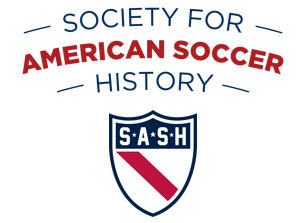At the 44th Annual Convention of the North American Society for Sports History held in Atlanta, Georgia, president elect Jan Todd noted that for the first time in the history of the organization there were more soccer papers than any other single sport. Twelve papers of which ten dealt directly with U.S. soccer history were presented in three different panels. This represents an important moment for U.S. soccer history and one that can direct new avenues for future research and collaboration.
In panel one titled “Pioneers, Professionals and Critics,” Brian Bunk, Professor of History at the University of Massachusetts-Amherst, presented ground-breaking research on the emergence of soccer in San Francisco. He argued that sport and soccer, in particular, became a space for Anglophone men from all over the world to express their masculinity. Social capital was developed and ethnic identities maintained across the city and surrounding area.
David Kilpatrick of New York’s Mercy College presented findings on the origins of the Cosmos name associated with the New York side that played in the North American Soccer League in the 1970s. He traced a New York team called the Cosmopolitan Association Football Club nicknamed the Cosmos to 1890s New York. Dr. Kilpatrick argued that this highlights the role of soccer pioneers in New York during the 1890s.
Gabe Logan, Associate Professor of History at Northern Michigan University, presented fascinating work on the U.S. Communist Party’s Workers’ Soccer Association between 1927-1935. Drawing from newspapers, archival pamphlets and memoirs his presentation further helps our understanding of the development of soccer in Chicago and New York in particular. Dr. Logan’s paper also mentioned women’s and African American soccer teams that were active during this period.
In the final presentation in the panel, Gary James, an expert on soccer in Manchester, used Britain as a case study in reconsidering the debates of the origins of soccer. In a rich presentation, he argued that in an era of digital archives, historians need to take a broad overview in understanding the development of the game rather than a narrow one that only considers references to soccer. He suggested that this will allow for an “all-encompassing” narrative to emerge.
In panel two titled “International Tours, Encounters and Leagues” Chris Bolsmann, Associate Professor of Sports Studies at California State University Northridge, kicked off the session by arguing that the Pilgrims and Corinthian tours of the first two decades of the 20th century were not “missionary” ones to spread football and challenge American football as commonly suggested but ones that generated profits for the touring Englishmen. This goes against the dominant narrative that the Corinthians in particular were amateur gentleman and Dr. Bolsmann argues that a more apt way of referring to them was “unscrupulous globe trotters.”
Dil Porter’s presentation highlighted new research on football tours between England and the U.S. Porter, Professor of History at De Montfort University’s International Centre for Sports History and Culture, discussed the Worcester (Massachusetts) County Sportsmanship Brotherhood tour in 1926 and 1929 to England and the reciprocal tours in 1927 and 1929 by the Worcestershire Sports Fellowship to the United States. Rather than a financial undertaking as in the case of the Corinthians, Porter argued that the purpose of the tours was to generate goodwill between two regions who shared a name, language and enjoyed the same sport.
In the final paper in panel two, George Kioussis, Assistant Professor of Kinesiology at California State University Northridge, provided a fascinating insight into the International Soccer League that existed for five years in the 1960s. Kioussis showed how entrepreneur and sports promoter William Cox was crucial in bringing foreign opposition to the U.S. His paper showed how Cox’s endeavor came into conflict with the United States Soccer Football Association who accused him of neglecting the development of grassroots football.
In the final panel titled “Soccer in America” Ian Plenderleith presented an overview of the North American Soccer League drawing from his book Rock ‘n Roll Soccer: The Short Life and Fast Times of the North American Soccer league (St. Martin’s Press, 2014). He argued the NASL signed big name foreign players and provided an entertaining environment for the fans.
Christopher Henderson, a graduate student in the University of Iowa’s Department of American Studies/Sports Studies, presented insightful data on fan culture amongst female supporters of Portland’s Rose City Riveters. Henderson made use of excellent visuals to show how female fans challenge masculine soccerscapes and normative sexualities.
Patrick Salkeld, a graduate student at the University of Central Oklahoma, provided new insights into the role that Ronald Reagan played in supporting the bid for the 1994 World Cup that was held in the U.S.
Finally, Zach Bigalke, Graduate Teaching Fellow at the University of Oregon, argued that the groundbreaking 1930 U.S. men’s soccer team that participated in the inaugural men’s World Cup in Uruguay, were primarily home grown players rather than foreign imports. This he argued was a culmination of a process of professionalization of the game in the U.S. and the development of the game within American immigrant communities.
The breadth and quality of the papers presented by established and newer scholars and graduate students dealing with U.S. soccer history is impressive. This suggests that studying soccer in a serious and scholarly way is gaining traction and is productive. While most papers dealt with white male soccer, ethnic minority and women’s soccer was highlighted too. The time has come to consider organizing a scholarly conference, with the sole focus on the multitude of exciting opportunities offered by US soccer history.
N.B.: This post was authored by Dr. Chris Bolsmann, the organizer of the panels at the recent NASSH conference in Atlanta.

